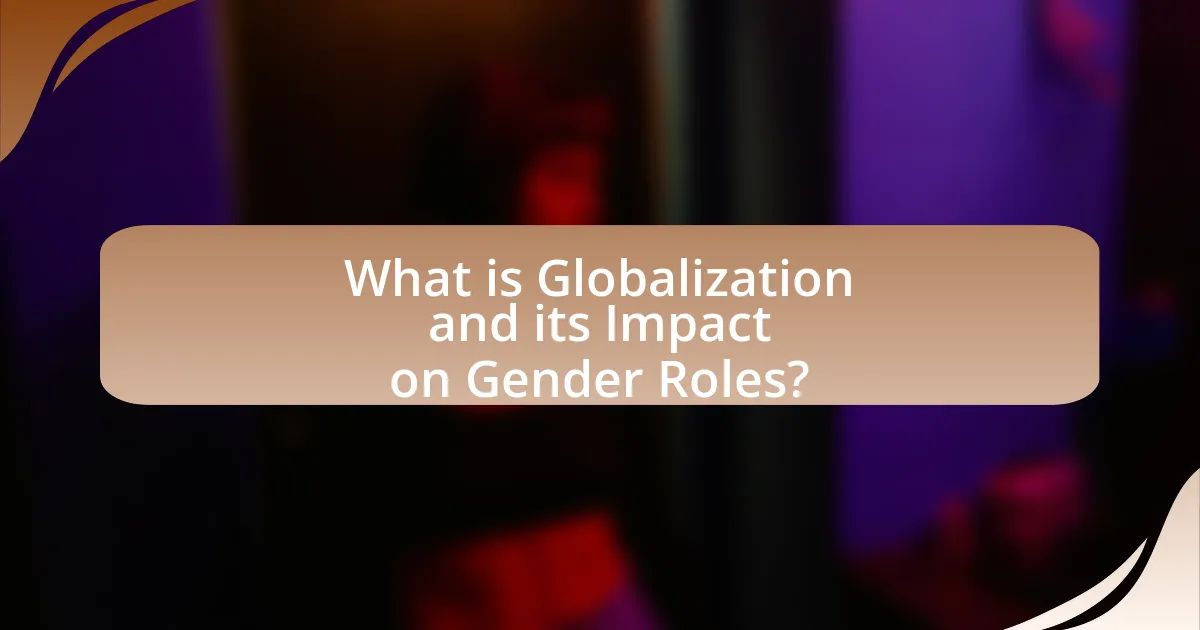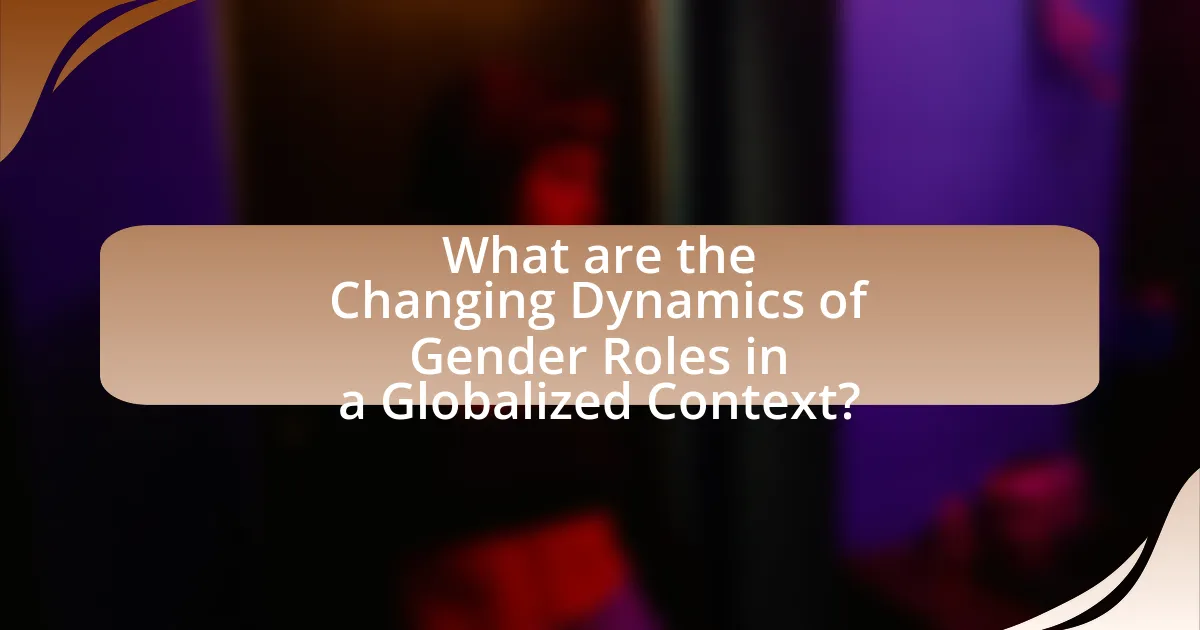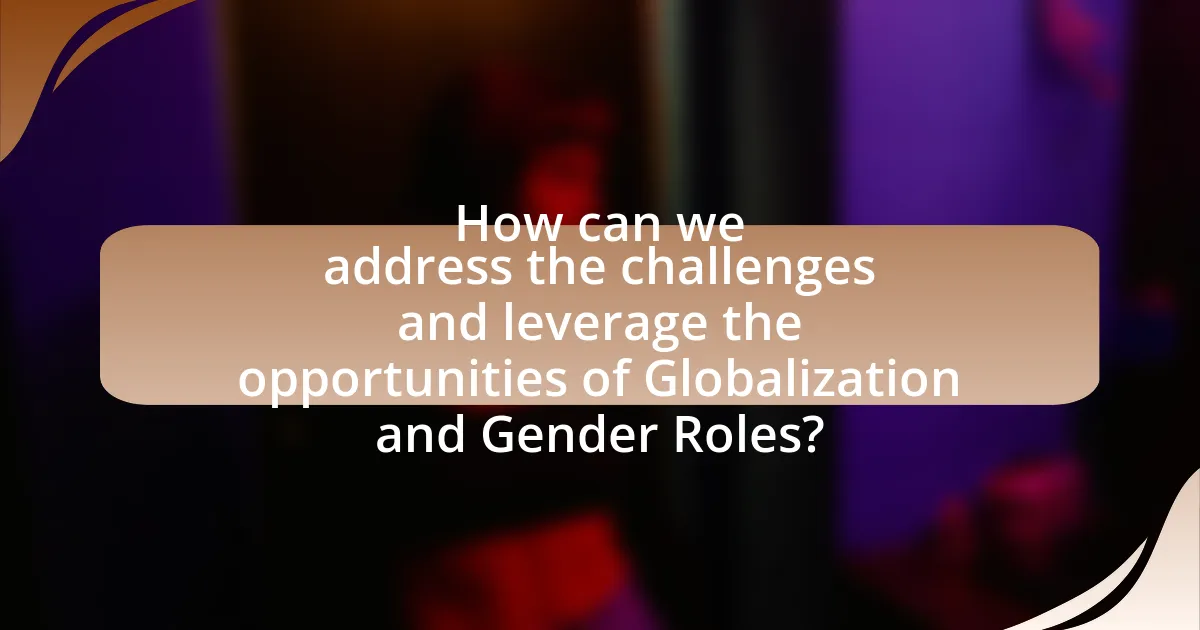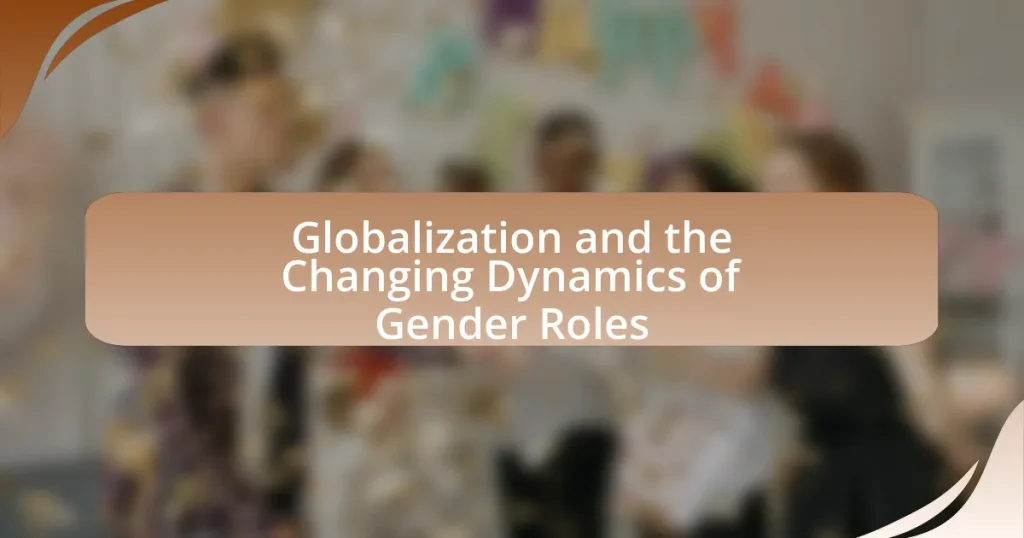Globalization refers to the increasing interconnectedness and interdependence among countries, significantly impacting gender roles by challenging traditional norms and creating new opportunities for women in various sectors. The article explores how globalization influences societal perceptions of gender, the historical factors shaping current gender dynamics, and the cultural differences affecting gender roles across regions. It also examines the key components of globalization that reshape gender expectations, the role of technology in transforming these roles, and the implications for future generations. Additionally, the article discusses the challenges and opportunities arising from these changing dynamics, emphasizing the importance of understanding this relationship for effective policy-making and social change.

What is Globalization and its Impact on Gender Roles?
Globalization is the process of increased interconnectedness and interdependence among countries, primarily driven by trade, investment, technology, and cultural exchange. This phenomenon has significantly impacted gender roles by challenging traditional norms and creating new opportunities for women in various sectors. For instance, the rise of global supply chains has led to increased employment for women in manufacturing and service industries, particularly in developing countries, where women now represent a substantial portion of the workforce. According to the International Labour Organization, women’s participation in the labor force has increased from 50% in 1990 to over 60% in some regions due to globalization. However, this shift also brings challenges, such as the persistence of gender wage gaps and exploitation in low-wage jobs. Thus, while globalization has opened doors for women, it has also highlighted the need for policies that promote gender equality and protect women’s rights in the workforce.
How does globalization influence societal perceptions of gender?
Globalization influences societal perceptions of gender by promoting the exchange of ideas and cultural practices across borders, leading to both the reinforcement and challenge of traditional gender roles. As global communication and trade increase, diverse perspectives on gender equality and women’s rights become more accessible, often resulting in shifts toward more progressive views in some societies. For instance, the United Nations reports that globalization has facilitated the spread of feminist movements and gender advocacy, which have contributed to increased awareness and legislative changes regarding gender equality in various countries. However, globalization can also exacerbate existing inequalities by commodifying gender roles and perpetuating stereotypes through media and advertising, as seen in the portrayal of women in global marketing campaigns.
What historical factors contributed to the current gender dynamics in a globalized world?
Historical factors such as colonialism, industrialization, and the feminist movements have significantly shaped the current gender dynamics in a globalized world. Colonialism often imposed patriarchal structures on colonized societies, disrupting existing gender roles and creating new hierarchies. Industrialization led to the migration of women into the workforce, challenging traditional domestic roles and contributing to economic independence. Additionally, the feminist movements of the 20th century advocated for women’s rights, influencing policies and societal norms globally. These historical events collectively established a framework for contemporary gender relations, where globalization further intertwines economic, cultural, and social factors, impacting gender roles worldwide.
How do cultural differences affect gender roles in various regions?
Cultural differences significantly shape gender roles across various regions by influencing societal norms, expectations, and behaviors associated with masculinity and femininity. For instance, in many Western cultures, gender roles have evolved towards greater equality, with women increasingly participating in the workforce and men taking on domestic responsibilities. In contrast, in some Middle Eastern and South Asian cultures, traditional gender roles remain more rigid, often emphasizing male authority and female subservience, as seen in practices like arranged marriages and limited female participation in public life. Research by the World Economic Forum in 2021 highlights that countries with more egalitarian cultural values tend to have smaller gender gaps in education and employment, illustrating how cultural context directly impacts gender role dynamics.
What are the key components of globalization affecting gender roles?
The key components of globalization affecting gender roles include economic integration, cultural exchange, and technological advancement. Economic integration, through global trade and labor markets, has increased women’s participation in the workforce, leading to shifts in traditional gender roles. For instance, the International Labour Organization reported that women’s labor force participation rose from 50% in 1990 to 60% in 2020 in many developing countries due to globalization. Cultural exchange, facilitated by media and migration, has introduced diverse perspectives on gender equality, challenging patriarchal norms. Additionally, technological advancement, particularly in communication, has empowered women by providing access to information and networks, which has been shown to enhance their social and economic status. These components collectively reshape gender roles by promoting equality and challenging traditional norms.
How do economic changes reshape gender expectations?
Economic changes reshape gender expectations by altering labor market dynamics and influencing societal roles. For instance, the rise of women in the workforce during the late 20th century, driven by economic necessity and globalization, challenged traditional gender roles that confined women to domestic responsibilities. According to the World Economic Forum’s Global Gender Gap Report, countries with higher female labor force participation tend to exhibit more progressive gender norms, indicating that economic participation can lead to shifts in societal expectations. Additionally, economic downturns often prompt a reevaluation of gender roles, as families adapt to financial pressures, leading to increased acceptance of non-traditional roles for both men and women.
What role does technology play in transforming gender roles globally?
Technology plays a crucial role in transforming gender roles globally by enabling greater access to information, resources, and opportunities for individuals regardless of gender. For instance, the rise of the internet and mobile technology has facilitated women’s access to education and employment, leading to increased participation in the workforce. According to a McKinsey Global Institute report, closing the gender gap in labor force participation could add $12 trillion to global GDP by 2025. Additionally, social media platforms have empowered women to voice their opinions and advocate for their rights, fostering a shift in societal norms around gender roles. These technological advancements not only challenge traditional stereotypes but also promote gender equality by providing tools for economic independence and social engagement.
Why is understanding the relationship between globalization and gender roles important?
Understanding the relationship between globalization and gender roles is important because it reveals how global economic, social, and cultural changes impact gender equality and women’s rights. Globalization often leads to shifts in labor markets, which can either empower women through increased employment opportunities or exacerbate inequalities by reinforcing traditional gender roles. For instance, the International Labour Organization reported that women are disproportionately represented in low-wage, informal sectors, highlighting the need for policies that address these disparities. Additionally, globalization influences cultural perceptions of gender, affecting societal norms and expectations. Recognizing these dynamics is crucial for developing effective strategies to promote gender equity in a rapidly changing global landscape.
How can this understanding influence policy-making and social change?
Understanding the changing dynamics of gender roles due to globalization can significantly influence policy-making and social change by promoting gender equality and inclusive practices. Policymakers can utilize this understanding to create frameworks that address disparities in economic opportunities, education, and healthcare access for different genders. For instance, research from the World Economic Forum indicates that countries with policies promoting gender equality experience higher economic growth and improved social outcomes. By integrating gender-sensitive approaches into legislation, such as parental leave policies and equal pay initiatives, governments can foster a more equitable society, ultimately leading to sustainable development and social cohesion.
What implications does this relationship have for future generations?
The relationship between globalization and changing gender roles will significantly impact future generations by promoting greater gender equality and economic opportunities. As globalization facilitates the exchange of ideas and cultural practices, it encourages societies to adopt more progressive views on gender roles, leading to increased participation of women in the workforce. For instance, the World Economic Forum’s Global Gender Gap Report 2021 indicates that countries with higher levels of globalization tend to have smaller gender gaps in economic participation and opportunity. This trend suggests that future generations may benefit from a more equitable society, where both men and women can pursue careers and education without traditional gender constraints.

What are the Changing Dynamics of Gender Roles in a Globalized Context?
The changing dynamics of gender roles in a globalized context involve a shift towards greater gender equality and the redefinition of traditional roles. Globalization has facilitated increased access to education and employment opportunities for women, leading to a rise in female participation in the workforce. For instance, the World Bank reported that women’s labor force participation has increased in many developing countries due to economic globalization, which has also contributed to changing societal norms regarding gender roles. Additionally, the proliferation of digital communication has enabled women to connect and advocate for their rights on a global scale, further challenging traditional gender norms. These changes reflect a broader trend towards recognizing and valuing diverse gender identities and roles in various cultural contexts.
How have traditional gender roles evolved due to globalization?
Traditional gender roles have evolved due to globalization by increasingly promoting gender equality and expanding women’s participation in the workforce. Globalization has facilitated the exchange of ideas and cultural practices, leading to shifts in societal norms that challenge traditional views on gender. For instance, the rise of multinational corporations has created job opportunities for women in various sectors, contributing to their economic independence. According to a report by the McKinsey Global Institute, closing gender gaps in labor force participation could add $12 trillion to global GDP by 2025, highlighting the economic benefits of this evolution. Additionally, exposure to diverse cultures through media and technology has fostered greater awareness and advocacy for women’s rights, further transforming traditional gender roles.
What new roles are emerging for women in the workforce?
New roles emerging for women in the workforce include positions in technology, leadership, and remote work facilitation. The rise of the digital economy has created demand for women in tech-related fields, such as software development and data analysis, where women now represent approximately 26% of the workforce, a significant increase from previous decades. Additionally, women are increasingly taking on leadership roles, with studies indicating that companies with female leaders tend to perform better financially. The shift towards remote work has also allowed women to balance professional and personal responsibilities more effectively, leading to greater participation in the workforce. These trends reflect the evolving landscape of gender roles influenced by globalization and changing societal expectations.
How are men’s roles being redefined in contemporary society?
Men’s roles are being redefined in contemporary society through increased participation in caregiving and domestic responsibilities. This shift is evidenced by changing societal expectations and policies that promote shared parenting, such as paternity leave initiatives. For instance, countries like Sweden and Norway have implemented parental leave policies that encourage fathers to take time off work, resulting in a significant increase in men engaging in childcare. Additionally, studies show that men are increasingly valuing work-life balance, leading to a more equitable distribution of household duties. This evolution reflects broader cultural changes that challenge traditional masculinity and promote gender equality.
What challenges do individuals face in adapting to these changing dynamics?
Individuals face several challenges in adapting to the changing dynamics of gender roles due to globalization. These challenges include navigating shifting societal expectations, reconciling traditional values with modern roles, and overcoming economic disparities that affect gender equality. For instance, as globalization promotes more egalitarian views, individuals from conservative backgrounds may struggle to align their beliefs with new norms, leading to identity conflicts. Additionally, the economic impact of globalization can exacerbate gender inequalities, as women may face barriers in accessing job opportunities or equal pay in emerging markets. Studies indicate that in many regions, women still earn significantly less than men, highlighting the persistent economic challenges that hinder adaptation to these evolving gender roles.
How do cultural resistance and backlash manifest in response to changing gender roles?
Cultural resistance and backlash manifest in response to changing gender roles through various forms of social opposition, including protests, legislative actions, and the reinforcement of traditional gender norms. For instance, in many societies, movements advocating for women’s rights and gender equality have faced significant pushback from conservative groups that seek to maintain established gender hierarchies. This resistance can be observed in countries where legal reforms aimed at promoting gender equality are met with counter-legislation that restricts women’s rights, such as laws limiting reproductive rights or enforcing traditional family structures. Additionally, cultural backlash often appears in media representations that glorify traditional gender roles, reinforcing stereotypes and stigmatizing those who challenge them. Research indicates that such backlash can be fueled by economic anxieties and perceived threats to cultural identity, leading to a resurgence of patriarchal values as a means of preserving social order.
What barriers exist for achieving gender equality in a globalized world?
Barriers to achieving gender equality in a globalized world include cultural norms, economic disparities, and legal inequalities. Cultural norms often perpetuate stereotypes that limit women’s roles in society, as seen in many regions where traditional views prioritize male authority. Economic disparities manifest in unequal access to resources, with women frequently earning less than men for similar work; for instance, the World Economic Forum reported in 2021 that the global gender pay gap is projected to take over 135 years to close at the current rate. Legal inequalities persist in various countries where laws do not protect women’s rights equally, hindering their ability to participate fully in economic and political spheres. These barriers collectively impede progress toward gender equality on a global scale.
What opportunities arise from the changing dynamics of gender roles?
The changing dynamics of gender roles create opportunities for increased workforce participation and economic growth. As traditional gender norms evolve, more women are entering the labor market, contributing to diverse skill sets and perspectives that enhance productivity. For instance, the McKinsey Global Institute reported that closing gender gaps in labor force participation could add $28 trillion to global GDP by 2025. Additionally, organizations that embrace gender diversity often experience improved innovation and decision-making, as diverse teams are more likely to consider a wider range of solutions. This shift not only empowers individuals but also fosters a more inclusive society, leading to broader social and economic benefits.
How can globalization promote gender equality and empowerment?
Globalization can promote gender equality and empowerment by increasing access to education and economic opportunities for women. As global markets expand, women gain greater access to jobs and entrepreneurial ventures, which can lead to financial independence and improved social status. For instance, the World Bank reported that women’s participation in the labor force can significantly boost economic growth, with estimates suggesting that closing gender gaps in labor force participation could increase GDP by up to 25% in some countries. Additionally, globalization facilitates the exchange of ideas and norms, promoting awareness of gender equality issues and encouraging policy changes that support women’s rights. This interconnectedness can lead to stronger advocacy networks and international support for gender equality initiatives.
What role do international organizations play in supporting gender equity?
International organizations play a crucial role in supporting gender equity by establishing frameworks, providing funding, and facilitating international cooperation. These organizations, such as the United Nations and the World Bank, implement policies and programs aimed at reducing gender disparities in various sectors, including education, health, and economic participation. For instance, the UN’s Sustainable Development Goal 5 explicitly aims to achieve gender equality and empower all women and girls by 2030, highlighting the global commitment to this issue. Additionally, the World Bank reports that investing in gender equality can significantly boost economic growth, with estimates suggesting that closing gender gaps in labor force participation could add $28 trillion to global GDP by 2025.

How can we address the challenges and leverage the opportunities of Globalization and Gender Roles?
To address the challenges and leverage the opportunities of globalization and gender roles, it is essential to implement policies that promote gender equality in economic participation and decision-making. Research indicates that countries with higher gender equality in the workforce experience increased economic growth; for instance, McKinsey Global Institute reported in 2015 that closing gender gaps in labor force participation could add $28 trillion to global GDP by 2025.
Additionally, fostering educational initiatives that empower women and girls in developing regions can mitigate the adverse effects of globalization, such as job displacement. The World Bank highlights that investing in women’s education leads to improved economic outcomes and social stability.
Furthermore, promoting inclusive corporate practices that support work-life balance and equal pay can enhance women’s roles in the global economy. The International Labour Organization emphasizes that gender-responsive policies in workplaces can lead to better productivity and employee satisfaction.
By addressing these areas, stakeholders can effectively navigate the complexities of globalization while maximizing the benefits of diverse gender roles in the workforce.
What strategies can be implemented to promote gender equality in a globalized context?
To promote gender equality in a globalized context, strategies such as implementing comprehensive education programs, enforcing legal frameworks, and fostering economic empowerment must be prioritized. Comprehensive education programs that focus on gender sensitivity can raise awareness and challenge stereotypes, as evidenced by initiatives like UNESCO’s Global Education Monitoring Report, which highlights the importance of education in reducing gender disparities. Enforcing legal frameworks, such as the Convention on the Elimination of All Forms of Discrimination Against Women (CEDAW), can provide a solid foundation for protecting women’s rights globally. Additionally, fostering economic empowerment through access to resources, training, and support for women entrepreneurs can significantly enhance their participation in the workforce, as shown by the World Bank’s findings that gender equality in labor markets can boost economic growth.
How can education and awareness campaigns contribute to changing perceptions?
Education and awareness campaigns can significantly change perceptions by providing accurate information and challenging stereotypes. These campaigns often utilize data and research to highlight the realities of gender roles, thereby fostering understanding and empathy. For instance, studies have shown that educational initiatives, such as those implemented by organizations like UN Women, have led to increased awareness of gender equality issues, resulting in shifts in public attitudes and behaviors. By addressing misconceptions and promoting inclusive narratives, these campaigns can effectively reshape societal views on gender roles, contributing to a more equitable environment.
What best practices can organizations adopt to support gender diversity?
Organizations can adopt several best practices to support gender diversity, including implementing equitable hiring processes, promoting inclusive workplace cultures, and providing mentorship programs. Equitable hiring processes involve using standardized criteria to evaluate candidates, which reduces bias and ensures that women and underrepresented genders have equal opportunities. Promoting inclusive workplace cultures can be achieved through training programs that raise awareness about gender biases and encourage respectful communication. Additionally, mentorship programs that connect women with leaders in their fields can enhance career development and retention rates. Research indicates that companies with diverse leadership teams are 33% more likely to outperform their peers in profitability, highlighting the importance of these practices in fostering gender diversity.
What are the implications for future research and policy development?
Future research and policy development must address the evolving impact of globalization on gender roles, as these dynamics significantly influence economic, social, and cultural structures. Understanding how globalization reshapes gender norms can inform policies that promote gender equality and empower marginalized groups. For instance, studies indicate that globalization can lead to both positive outcomes, such as increased labor participation among women, and negative consequences, such as the reinforcement of traditional gender roles in certain contexts. Therefore, research should focus on identifying specific mechanisms through which globalization affects gender dynamics, enabling policymakers to create targeted interventions that support equitable outcomes.
How can interdisciplinary approaches enhance our understanding of globalization and gender roles?
Interdisciplinary approaches enhance our understanding of globalization and gender roles by integrating diverse perspectives from sociology, economics, cultural studies, and political science. This integration allows for a comprehensive analysis of how global economic systems, cultural exchanges, and political policies intersect to shape gender identities and roles across different societies. For instance, research by the World Bank indicates that gender inequality in labor markets is influenced by both economic policies and cultural norms, demonstrating the need for a multifaceted approach to address these issues effectively. By examining these intersections, interdisciplinary frameworks can reveal the complexities of how globalization impacts gender roles, leading to more informed and effective strategies for promoting gender equality.
What role does community engagement play in fostering gender equity?
Community engagement plays a crucial role in fostering gender equity by creating inclusive platforms for dialogue and collaboration among diverse stakeholders. Through initiatives such as community workshops, advocacy groups, and local partnerships, individuals can address gender disparities, share experiences, and develop collective strategies for change. Research indicates that communities with active engagement in gender equity initiatives see a measurable increase in women’s participation in decision-making processes, as evidenced by a study from the World Bank, which found that community-driven development projects led to a 20% increase in women’s leadership roles in participating regions. This demonstrates that when communities actively engage in discussions and actions surrounding gender equity, they can effectively challenge and transform existing gender norms and inequalities.
What practical steps can individuals take to support gender equality in their communities?
Individuals can support gender equality in their communities by actively promoting inclusive practices and advocating for equal rights. They can participate in local organizations that focus on gender equality, volunteer for initiatives that empower women and marginalized genders, and educate themselves and others about gender issues. Research indicates that communities with active gender equality programs see a 30% increase in women’s participation in leadership roles, demonstrating the effectiveness of grassroots efforts. Additionally, individuals can challenge discriminatory behaviors and language in their daily interactions, fostering a culture of respect and equality.










